The analogy of a caterpillar transforming into a butterfly beautifully encapsulates the evolution of a customer’s relationship with your brand over time. This journey, known as Lifecycle Marketing, is not merely conceptual but is grounded in data-driven insights. It comprises a series of distinct stages that delineate the progression from the first encounter to becoming loyal advocates.
What is Lifecycle Marketing?
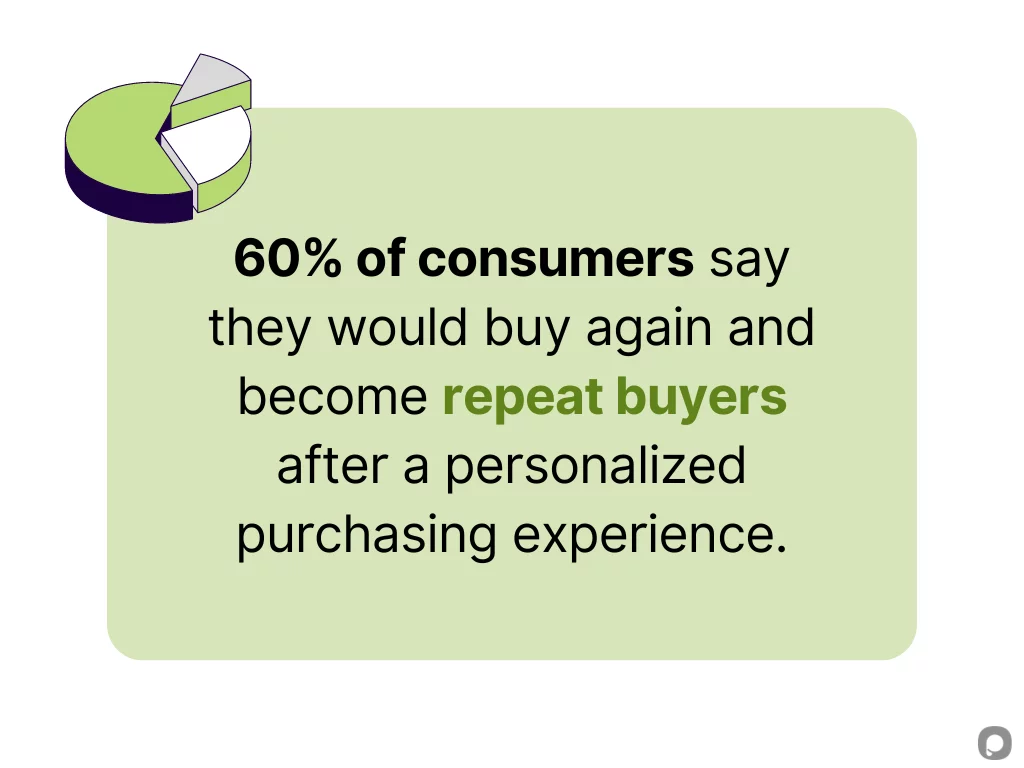
Lifecycle marketing involves tracing the entire journey of a customer’s relationship with your brand, from initial discovery to becoming a loyal, repeat purchaser. Much like the transformation of a caterpillar into a butterfly, this process emphasizes the development of a deeper, more personalized connection over time. Remarkably, 60% of consumers express a willingness to make repeat purchases after experiencing personalized buying journeys.
To achieve this, it’s essential to tailor communications and offers to suit the needs of each stage in the customer’s lifecycle. By strategically planning your approach for individuals at different lifecycle stages, you can optimize your marketing efforts more effectively.
The 6 Stages of Lifecycle Marketing:
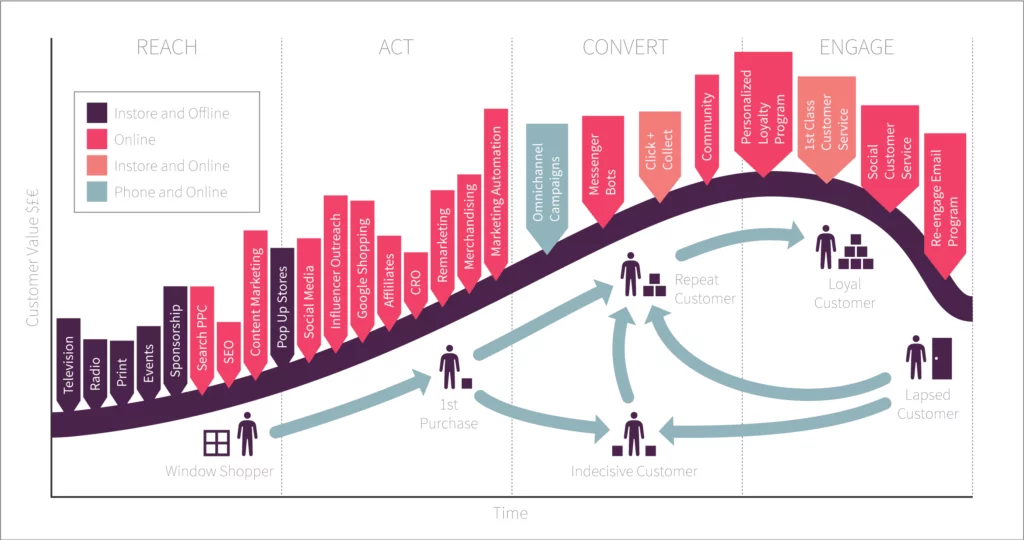
The journey through lifecycle marketing comprises six pivotal stages, each representing a significant juncture in the customer’s interaction with your brand.
- Stage 1: Awareness At the onset of the customer journey, the awareness stage introduces your brand to potential customers. Did you know that 87% of shoppers begin their product searches online? Strategies at this stage aim to capture attention and generate interest. Content marketing, social media engagement, and targeted advertising campaigns play pivotal roles in raising brand awareness. For example, Dollar Shave Club’s viral video campaign resulted in over 12,000 new subscribers within 48 hours, effectively introducing its brand to a wider audience.
- Stage 2: Consideration Once aware of your brand, potential customers enter the consideration stage, where they evaluate their options and weigh the benefits. Research shows that 81% of consumers conduct online research before making a purchase. Providing informative content such as product demos, comparison guides, and customer testimonials helps nurture leads during this phase. For example, HubSpot’s comprehensive educational resources have contributed to a 36% increase in lead generation for businesses adopting inbound marketing strategies.
- Stage 3: Conversion The conversion stage marks the pivotal moment when a prospect becomes a customer by making a purchase or completing a desired action. Did you know that personalized calls-to-action convert 202% better than generic ones? Streamlining the purchasing process, offering incentives like discounts or free trials, and providing exceptional customer service can all facilitate conversions. For example, Amazon’s one-click ordering and personalized product recommendations have contributed to a conversion rate 300% higher than the industry average.
- Stage 4: Retention After making a purchase, the focus shifts to retaining customers and fostering long-term relationships. Research indicates that increasing customer retention rates by just 5% can lead to a 25% to 95% increase in profits. Strategies for retention include personalized communication, loyalty programs, and proactive customer support. For example, Starbucks’ loyalty program boasts over 19.4 million active members, driving repeat business and contributing to a 15% increase in revenue.
- Stage 5: Advocacy Satisfied customers often become brand advocates, spreading positive word-of-mouth and influencing others’ purchasing decisions. Did you know that 92% of consumers trust recommendations from friends and family more than any other form of advertising? Encouraging and incentivizing customer referrals, showcasing user-generated content, and actively engaging with brand enthusiasts can amplify advocacy efforts. For example, Airbnb’s referral program has resulted in over 11 million guest referrals and a 300% increase in bookings from referred users.
- Stage 6: Loyalty At the pinnacle of the customer lifecycle, loyal customers emerge as brand ambassadors who champion your brand consistently. Research shows that loyal customers are five times more likely to repurchase and four times more likely to refer others to your brand. Cultivating loyalty involves ongoing engagement, personalized rewards, and exclusive perks to reinforce the bond between customers and your brand. For example, Apple’s loyal fan base eagerly anticipates product launches, participates in exclusive events, and proudly advocates for the brand across various platforms, contributing to Apple’s impressive customer loyalty index score of 70%.
Strategies and Real Life Examples of Lifecycle Marketing:
A. Crafting an Effective Awareness Stage Lifecycle Marketing Strategy
The awareness stage marks the initiation of your customer’s journey, where the primary focus is on elevating brand visibility and ensuring potential customers become acquainted with your offerings. Here’s a detailed breakdown of effective tactics and strategies to bolster awareness:
- Search Engine Optimization (SEO) & Content Marketing: SEO forms the cornerstone of digital visibility. Start by conducting thorough keyword research to understand the language and queries potential customers use when searching for products or services akin to yours. Once armed with valuable keywords, strategically integrate them throughout your website, with particular emphasis on meta titles, descriptions, and headers. This optimization enhances your website’s discoverability in search engine results pages (SERPs). Expand your digital footprint through backlink acquisition. Collaborate with reputable websites within your niche to secure backlinks pointing to your content. These backlinks not only drive direct traffic but also signal to search engines the authority and relevance of your website.
- Social Media Marketing: Social media platforms serve as vibrant hubs for brand engagement. Tailor your platform selection based on your target audience demographics and preferences. For instance, LinkedIn is apt for professional and B2B markets, while Instagram and TikTok cater more to B2C and younger demographics. Actively engage with your audience by promptly responding to queries, comments, and messages. Host interactive sessions, polls, or live Q&A sessions to foster meaningful connections and deepen engagement.
🌟 An illustrative example of effective social media engagement is Skullcandy‘s utilization of Instagram Stories. Through this medium, they address frequently asked questions and spotlight product features, effectively captivating potential customers.

- Pay-Per-Click (PPC) Advertising: Leverage PPC campaigns on search engines to secure prime placements in SERPs for chosen keywords. PPC advertising ensures your brand appears prominently when potential customers are actively searching for related products or services. Complement your search-based PPC efforts with display ads strategically placed on relevant websites and platforms. These visually engaging ads capture the attention of potential customers as they browse content related to your industry.
- Influencer Collaborations: Forge strategic partnerships with non-competing brands or influencers whose audience aligns with your target demographic. Collaborate on co-created content or joint promotional campaigns to expand your brand’s reach and resonance. In industries where credibility and trust are paramount, affiliating with well-known influencers or brands can significantly enhance your brand’s reputation and credibility.
🌟 A standout example of successful influencer collaboration is the partnership between Lifesum and Dutch Instagram influencer Rianne Meijer, showcasing the power of leveraging influencer endorsements.
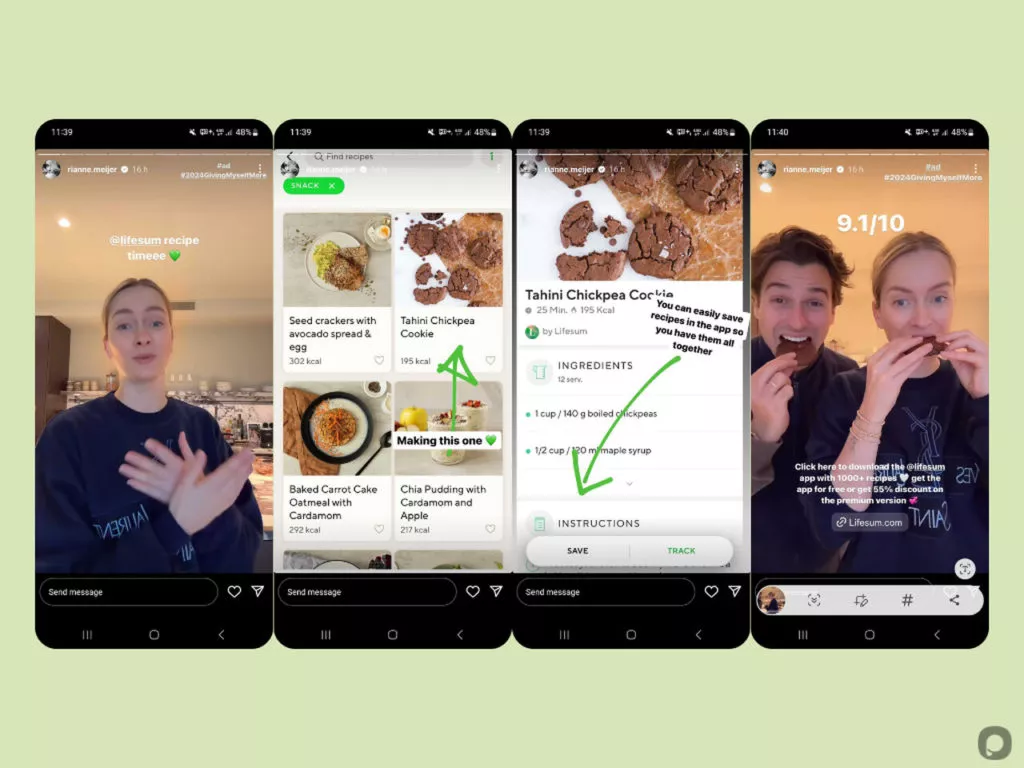
- Public Relations and Media Outreach:Elevate your brand’s visibility through proactive public relations and media outreach efforts. Craft compelling press releases highlighting significant company events, product launches, or compelling narratives that capture media attention. Nurture relationships with journalists, bloggers, and industry influencers to secure favorable coverage and endorsements. Actively participate in relevant business events, conferences, and online seminars to amplify your brand’s exposure within your target audience.
By meticulously implementing these multifaceted strategies, you can effectively elevate awareness of your brand during the pivotal awareness stage of the lifecycle marketing process, laying a solid foundation for subsequent stages of customer engagement and conversion.
B. Crafting an Effective Strategy for the Interest Stage in Lifecycle Marketing
As potential customers transition from the awareness to the consideration stage, it becomes crucial to deepen their interest and guide them further through the marketing funnel. Here’s a comprehensive lifecycle marketing strategy tailored specifically for the interest stage:
- Segmented Email Nurture Sequences: Utilize data-driven segmentation to divide your email list based on user behavior such as website interactions, content downloads, or product views. Craft personalized email nurture sequences that gradually provide valuable information, guiding subscribers through the decision-making process.
- Interactive Content Experiences: Enhance engagement by offering interactive quiz funnels tailored to individual preferences. For instance, consider implementing a “Discover Your Ideal Skincare Routine” quiz for a skincare brand. Collect data from these interactions to personalize subsequent emails, addressing specific customer needs and preferences.
🌟 For example, Blume’s quick quiz effectively matches customers with suitable products, enhancing sales based on personalized recommendations.

- Educational Content Provision: Produce informative blog posts, infographics, and videos addressing common questions and providing detailed insights about your offerings. Incorporate compelling calls-to-action (CTAs) within this content, directing users to related success stories or user reviews to showcase practical applications and results.
- Retargeting Ads Based on Content Engagement: Implement retargeting ads aimed at users who have interacted with your content but haven’t taken further action. Customize ad content to match the specific interests and preferences of these users, ensuring your brand remains top-of-mind.
- Exclusive Access, Early-Bird Offers & Free Shipping: Incentivize potential customers by offering exclusive access to new products, special deals, or free shipping. Capitalize on this opportunity to solicit feedback, making customers feel valued and strengthening their interest in your brand.
🌟 For instance, Popupsmart’s popup example offers free shipping in exchange for feedback, fostering customer engagement and loyalty.
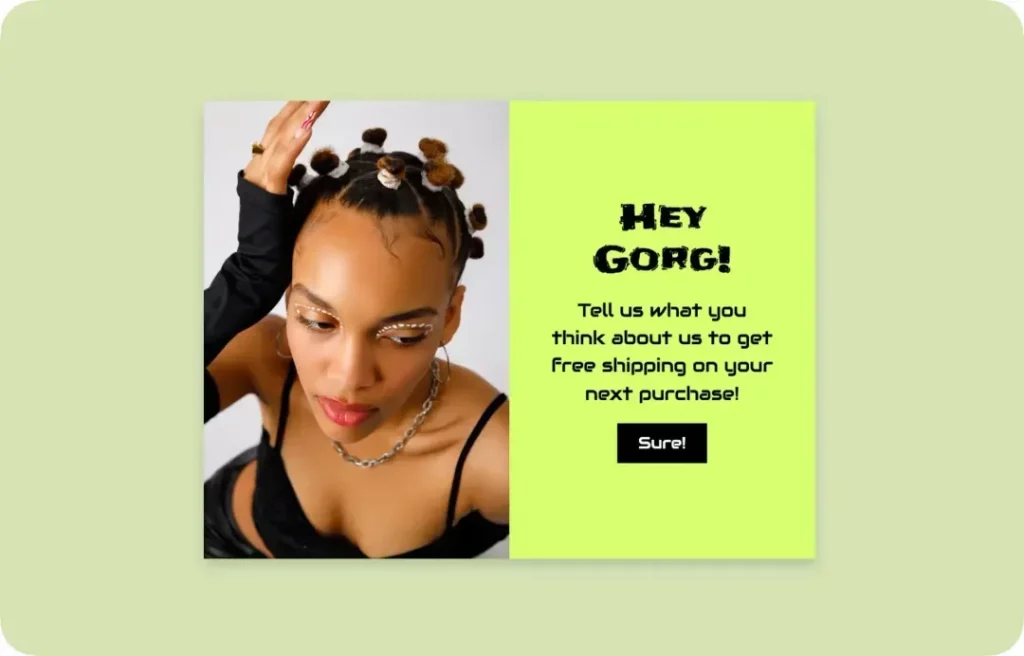
By implementing these multifaceted strategies, you can effectively nurture interest among potential customers, moving them closer to conversion while simultaneously fostering a deeper connection with your brand.
C. Transitioning Customers through the Consideration Stage: Lifecycle Marketing Strategy
As potential customers progress through the consideration stage, where they actively evaluate their options, it’s essential to provide compelling reasons for them to choose your brand. Here’s a detailed lifecycle marketing strategy tailored for this critical stage:
- Leveraging Customer Testimonials, Reviews, UGC: Harness the power of authentic testimonials, reviews, and user-generated content (UGC) to showcase real-life experiences with your products. These testimonials serve as powerful social proof, compelling others to choose your brand.
🌟 For example, Bison Coolers effectively utilizes a UGC section on its website, showcasing real videos of satisfied customers using their products.
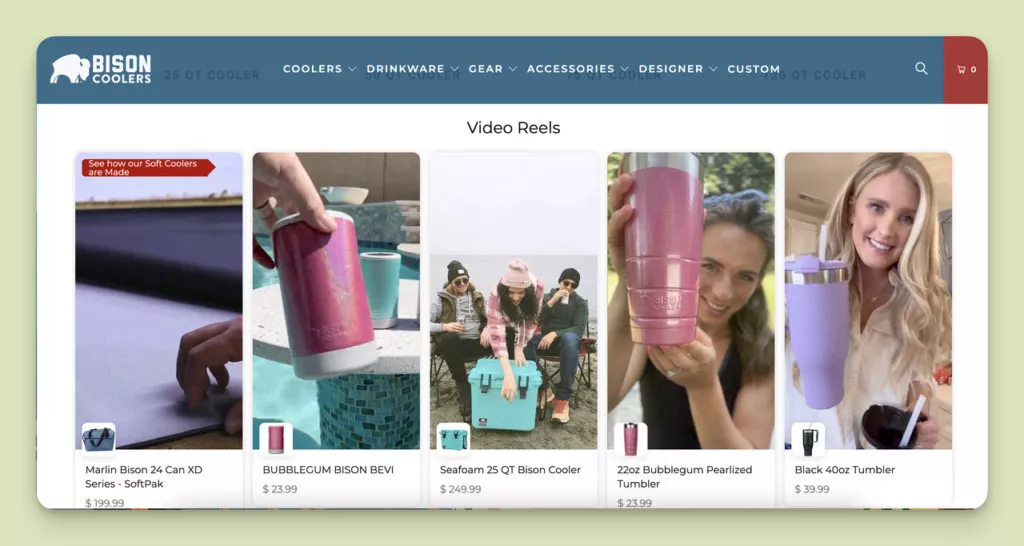
- Product Demos or Trial Offers: Provide prospective customers with opportunities to experience your product firsthand through demos or trial offers. This “try before you buy” approach instills confidence in your product and helps customers make informed decisions.
- Creating Comparison Guides: Develop clear and concise comparison charts highlighting the advantages of your product over competitors. Focus on key features such as durability, performance, or value proposition to showcase your product’s superiority.
- Comprehensive FAQ Sections: Anticipate and address common questions and concerns potential customers may have during the consideration stage. Develop a comprehensive FAQ section on your website to provide clarity and instill confidence in your brand.
🌟 Partake’s FAQ page serves as an excellent example, providing comprehensive answers to important questions, enhancing user understanding and confidence.
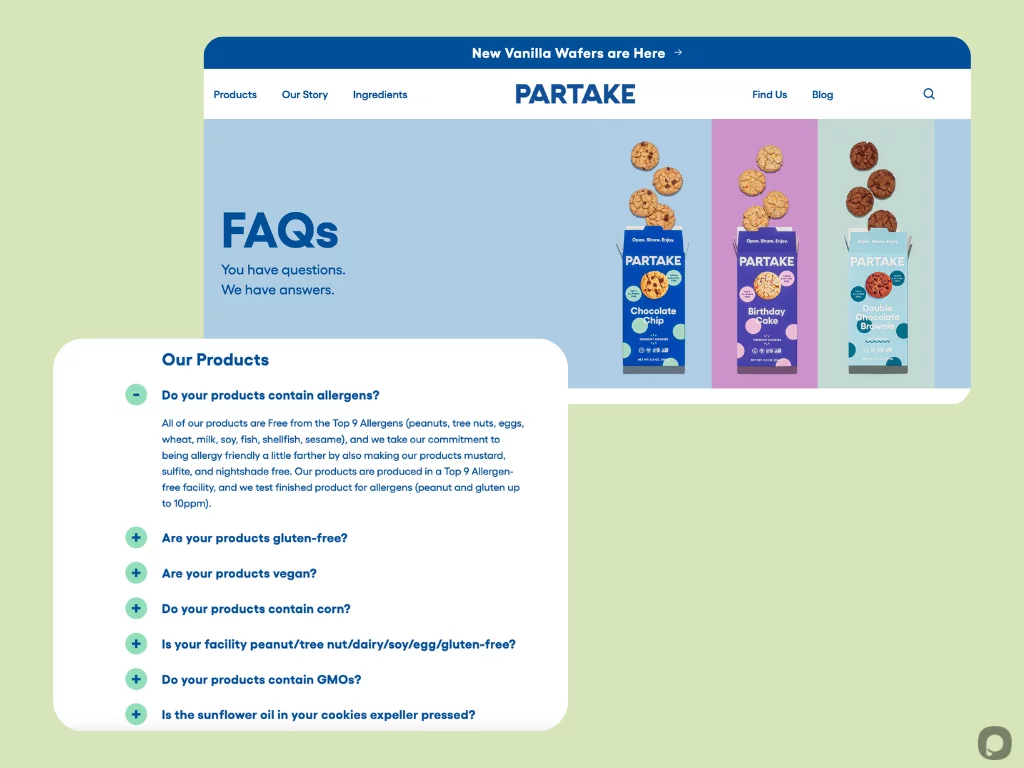
- Hosting Live Q&A Sessions: Engage with potential customers through interactive live sessions to address their queries and concerns directly. Position yourself as a knowledgeable and accessible expert, reassuring potential customers and demonstrating your commitment to their needs.
Stay abreast with the latest trends in ecommerce here.
D. Crafting an Effective Strategy for the Purchase Stage in Lifecycle Marketing
As customers approach the crucial decision-making phase of their journey, your marketing strategy must focus on nudging them towards completing the purchase. Here’s how to optimize your lifecycle marketing approach for this pivotal moment:
- Streamlined Checkout Process: Streamline the checkout process by minimizing the number of steps required to complete a purchase. Reduce checkout abandonment by simplifying the information customers need to input. Offer a guest checkout option to cater to customers who prefer not to create an account. Provide diverse payment options, including credit cards, PayPal, and other digital wallets, to accommodate various preferences.
- Retargeting Strategies & Cart Abandonment Emails: Implement retargeting ads to gently remind visitors who haven’t made a purchase to reconsider. Utilize these ads to bring back potential customers who may have left your site without completing their purchase. Send cart abandonment emails to remind customers of items left in their cart, encouraging them to complete their purchase.
🌟 For instance, Le Puzz’s cart abandonment email effectively reminds customers about their pending purchase, encouraging them to complete the transaction.
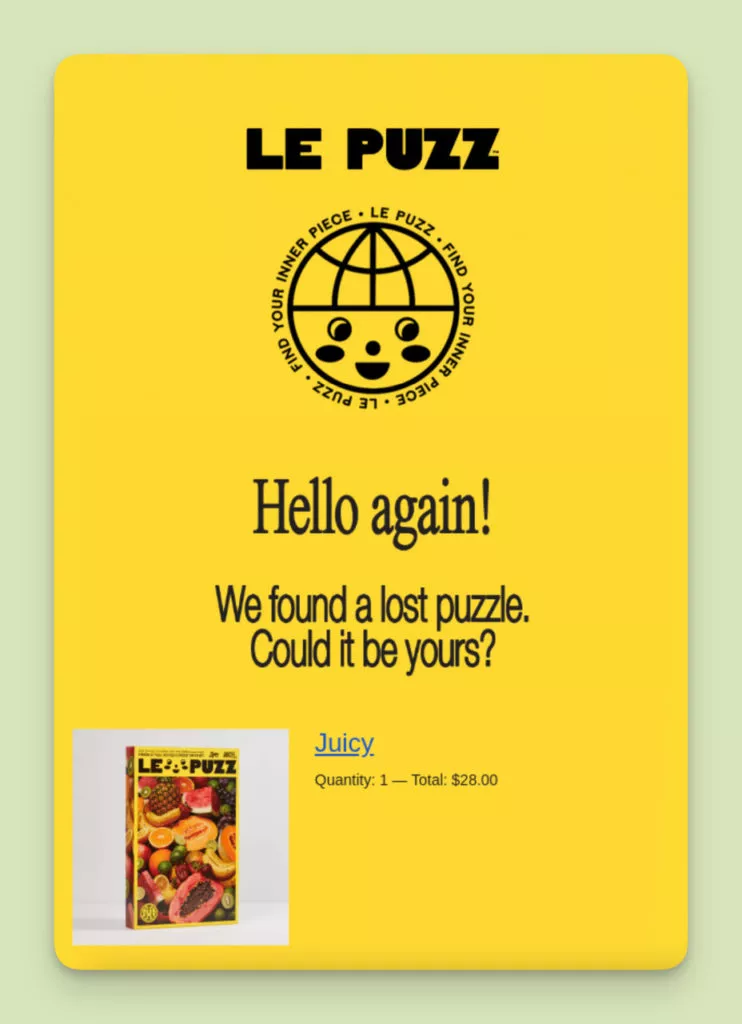
- Cross-Selling and Upselling: Enhance revenue opportunities by implementing cross-selling and upselling strategies during checkout. Recommend related products or upgrades to complement customers’ current purchases. Utilize data-driven insights to recommend products that align with customers’ preferences and previous purchase history.
🌟 Press’s “You May Also Like” section on their checkout process serves as an effective tool for cross-selling and upselling opportunities.
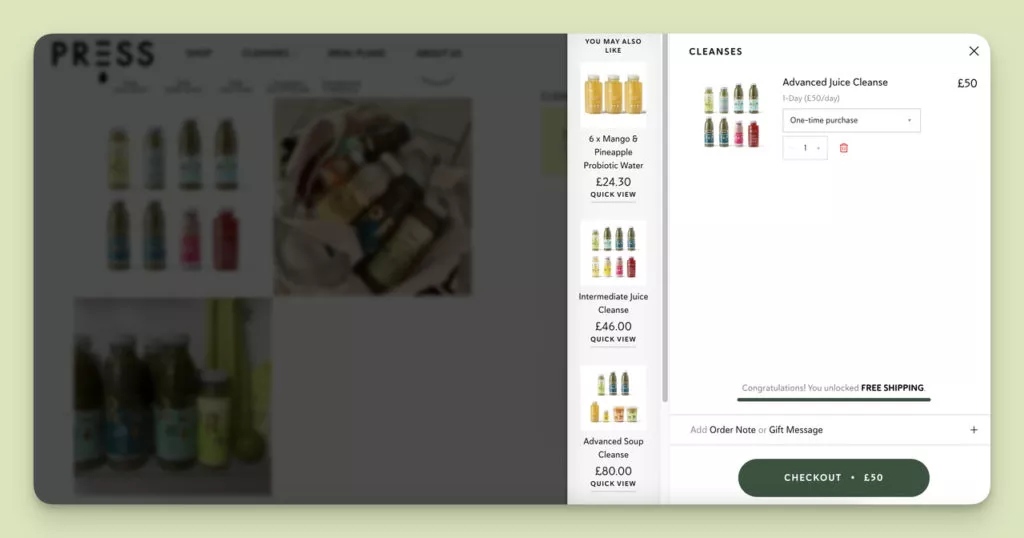
- Chat Support: Offer real-time chat support on your website, especially on the checkout page, to address customers’ immediate questions or concerns. Providing instant assistance can help alleviate any hesitations customers may have and facilitate a smooth checkout process.
- Post-Purchase Engagement: Cultivate ongoing relationships with customers even after they’ve made a purchase. Send personalized thank-you emails expressing gratitude for their patronage. Encourage feedback from customers to gather insights into their experience with your product or service. Provide tips on how to maximize the value of their purchase, demonstrating your commitment to their satisfaction.
E. Transitioning to the Retention Stage: Lifecycle Marketing Strategy
As customers transition from making a purchase to becoming loyal advocates, it’s vital to implement a comprehensive lifecycle marketing strategy tailored for the retention stage. Here’s how to foster enduring relationships and drive customer loyalty:
- Thank-You Emails & Effective Onboarding: Send personalized thank-you emails to customers after every purchase to express appreciation for their business. Follow up with a structured onboarding sequence, providing clear instructions, tips, and resources to ensure customers can fully utilize and enjoy their purchase.
🌟 For example, Hers’s onboarding email effectively guides customers on how to make the most of their products, enhancing the overall user experience.
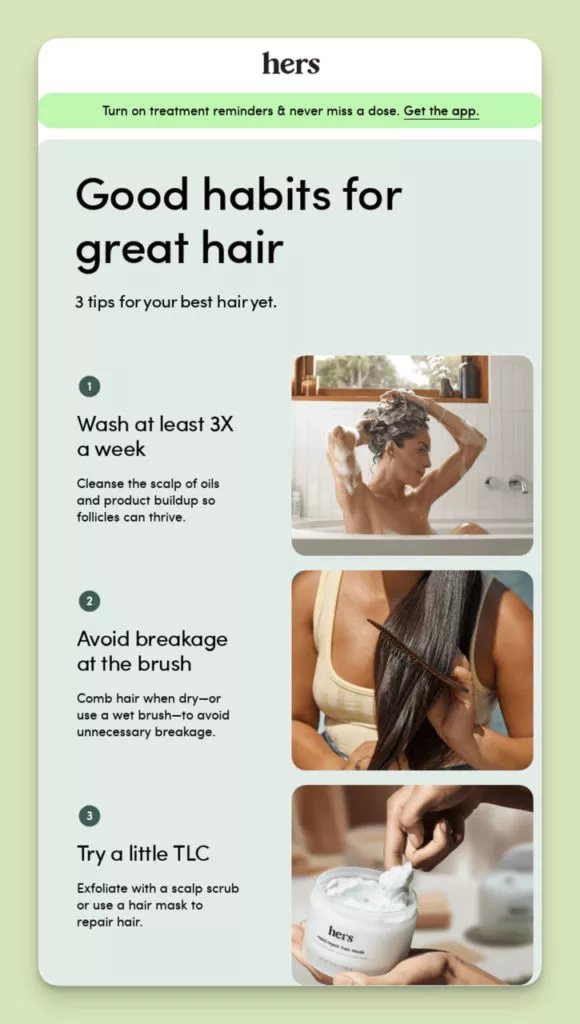
- Customer Feedback Surveys: Gather valuable insights into customers’ experiences by delivering short, focused feedback surveys on a regular basis. Utilize this feedback to drive continual improvement and demonstrate to customers that their opinions are valued and taken into account. Offer incentives to encourage survey completion, enhancing engagement.
- Exclusive Offers for Returning Customers & Re-engagement Campaigns: Target inactive customers with re-engagement campaigns, offering special incentives or reminders of unused benefits. Provide exclusive offers and rewards for returning customers to foster repeat business and incentivize loyalty.
- Membership Benefits: Implement membership benefits to deliver continuous value and foster a sense of belonging among customers. Offer exclusive perks, rewards, and discounts to members, encouraging ongoing engagement and loyalty.
- Regular Check-ins and Updates: Establish a schedule for reaching out to customers with updates about your company, new product releases, or relevant content based on their purchase history and preferences. Maintain consistent communication to keep customers informed and engaged, strengthening the relationship and encouraging repeat business.
🌟 For example, TicketTailor’s monthly email newsletter effectively keeps customers informed about company updates and news, enhancing engagement and retention.
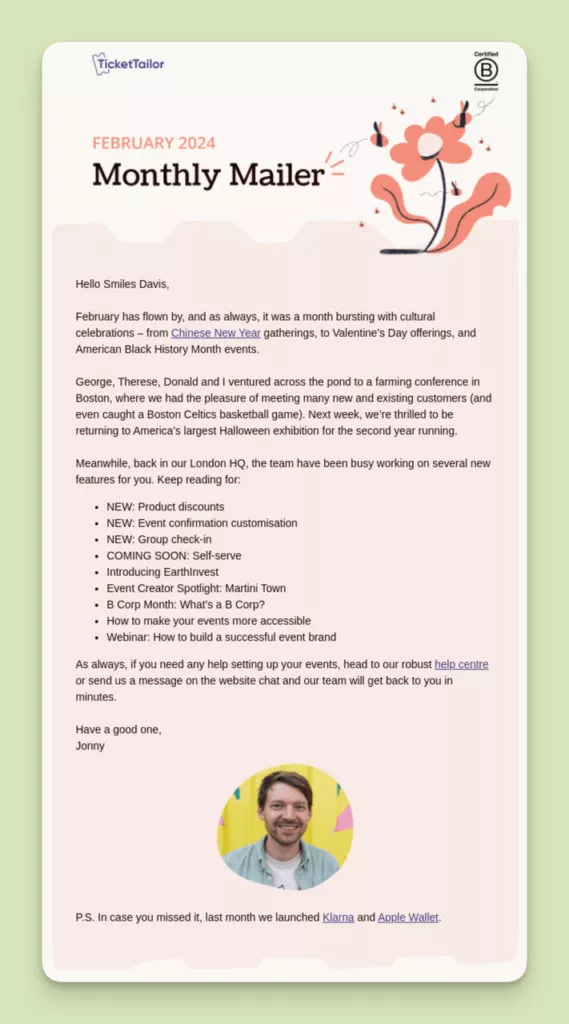
Wrap Up:
Lifecycle marketing is a dynamic approach that tailors strategies to each stage of the customer’s journey with your brand, thereby enhancing their experience and strengthening the connection with them.
From boosting brand awareness through SEO optimization and targeted ads, to nurturing interest with personalized content and enticing offers, to aiding consideration with compelling customer testimonials and engaging product demos, the focus remains on guiding customers through their journey. Moreover, the emphasis continues post-purchase, where ongoing engagement, exclusive benefits, and sincere appreciation work together to foster customer loyalty.
This comprehensive process not only increases customer retention and lifetime value but also provides invaluable insights to drive sustainable business growth.
FAQs on Lifecycle Marketing:
What Are Some Common Challenges in Implementing Lifecycle Marketing?
Some common challenges in implementing lifecycle marketing include aligning internal teams and departments to ensure seamless execution across various touchpoints, collecting and analyzing customer data to inform targeted campaigns, and maintaining consistency in messaging and branding throughout the customer journey. Additionally, businesses may face difficulties in accurately measuring the impact of lifecycle marketing efforts and adjusting strategies accordingly. Overcoming these challenges requires a strategic approach, investment in technology and resources, and a commitment to continuous improvement and adaptation.
How Can Small Businesses Implement Lifecycle Marketing Strategies?
Small businesses can implement lifecycle marketing strategies by first understanding their target audience and mapping out the customer journey. From there, they can develop personalized messaging and content for each stage of the lifecycle, leveraging email marketing, social media, and other channels to engage customers. Utilizing marketing automation tools can streamline processes and ensure consistent communication. Additionally, collecting and analyzing customer feedback and data can provide insights for refining strategies and enhancing the overall customer experience.
Are there any specific industries or types of businesses that can benefit most from implementing lifecycle marketing?
Certain industries and business types can benefit greatly from lifecycle marketing, particularly those with longer customer lifecycles or subscription-based models. This includes industries such as Software as a Service (SaaS), e-commerce, subscription boxes, telecommunications, financial services, and healthcare. However, virtually any business that values long-term customer relationships and repeat purchases can benefit from implementing lifecycle marketing strategies.
How can businesses balance automation and personalization in their lifecycle marketing efforts to maintain a human touch?
Businesses can balance automation and personalization by utilizing technology to streamline processes while ensuring that communication feels personalized and human. This can be achieved by segmenting audiences based on behavior or preferences and delivering targeted messages that resonate with each segment. Additionally, businesses should prioritize authenticity in their messaging, using language and tone that align with their brand personality. Regularly monitoring and adjusting automated campaigns based on customer feedback and engagement can also help maintain a human touch.
How does social media integration contribute to the effectiveness of lifecycle marketing strategies?
Social media integration enhances lifecycle marketing strategies by providing additional touchpoints for engagement throughout the customer journey. It allows businesses to interact with customers in real-time, gather feedback, and share relevant content. Social media platforms also offer opportunities for targeted advertising based on customer behavior and interests, as well as fostering community and brand advocacy. By integrating social media into lifecycle marketing efforts, businesses can strengthen relationships with customers and increase brand visibility and loyalty.
What metrics and KPIs (Key Performance Indicators) should businesses track to measure the success of their lifecycle marketing campaigns?
Businesses should track a variety of metrics and KPIs to measure the success of their lifecycle marketing campaigns, including:
- Customer Acquisition Cost (CAC): The cost associated with acquiring a new customer.
- Customer Lifetime Value (CLV): The total revenue a customer is expected to generate over their lifetime.
- Conversion Rates: The percentage of prospects that convert into customers at each stage of the lifecycle.
- Customer Retention Rate: The percentage of customers retained over a specific period.
- Net Promoter Score (NPS): A measure of customer satisfaction and loyalty based on the likelihood of customers to recommend the business to others.
- Engagement Metrics: Including open rates, click-through rates, and response rates for emails and other marketing communications.
- Revenue Attribution: Tracking revenue generated from specific marketing campaigns or channels to understand their impact on overall sales and profitability. By monitoring these metrics, businesses can assess the effectiveness of their lifecycle marketing efforts and make data-driven decisions to optimize performance and drive growth.



